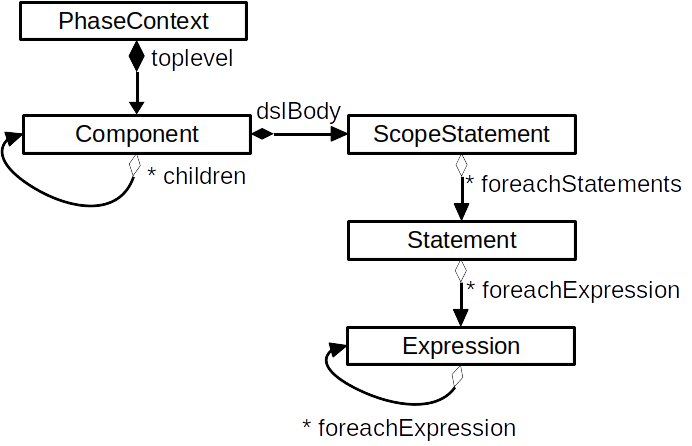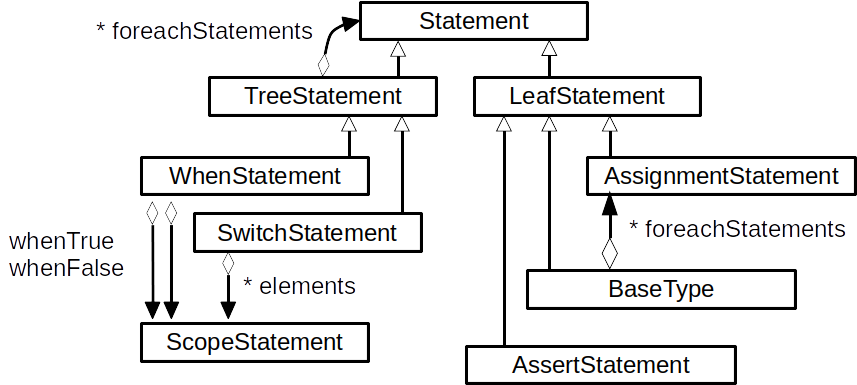SpinalHDL internal datamodel
Introduction
This page document the internal data structure user by SpinalHDL to store and modify the netlist described by the user through the SpinalHDL API.
General structure
The following diagrams follow the UML nomenclature :
A link with a white arrow mean “base extend target”
A link with a black diamond mean “base contains target”
A link with a white diamond mean “base has a reference to target”
The * symbole mean “multiple”
Most of the data structure is stored via some double linked list to ease the insertion and the removal of elements.
There is a diagram of the global data structure :

And here more details about the Statement class :

So in general, if a element of the datamodel use some other Expression or Statements, that element will have some functions to iterate over those usages. For instance, each Expression has a foreachExpression function.
When using those iterating functions, you are allowed to remove the current element of the tree.
Also asside the foreachXXX, which “only” iterate one level deep, there is often a walkXXX which will iterate recursively. So for instance myExpression.walkExpression on ((a+b)+c)+d will go through the whole tree of adders.
There is also utilities as myExpression.remapExpressions(Expression => Expression) which will iterate over all used expression of myExpression, and change it for your returned one.
More generaly, most of the graph checks and transformations done by SpinalHDL are located in <https://github.com/SpinalHDL/SpinalHDL/blob/dev/core/src/main/scala/spinal/core/internals/Phase.scala>
Exploring the datamodel
Here is an example which find all adders of the netlist without using “shortcuts” :
object FindAllAddersManualy {
class Toplevel extends Component{
val a,b,c = in UInt(8 bits)
val result = out(a + b + c)
}
import spinal.core.internals._
class PrintBaseTypes(message : String) extends Phase{
override def impl(pc: PhaseContext) = {
println(message)
recComponent(pc.topLevel)
def recComponent(c: Component): Unit = {
c.children.foreach(recComponent)
c.dslBody.foreachStatements(recStatement)
}
def recStatement(s: Statement): Unit = {
s.foreachExpression(recExpression)
s match {
case ts: TreeStatement => ts.foreachStatements(recStatement)
case _ =>
}
}
def recExpression(e: Expression): Unit = {
e match {
case op: Operator.BitVector.Add => println(s"Found ${op.left} + ${op.right}")
case _ =>
}
e.foreachExpression(recExpression)
}
}
override def hasNetlistImpact = false
override def toString = s"${super.toString} - $message"
}
def main(args: Array[String]): Unit = {
val config = SpinalConfig()
//Add a early phase
config.addTransformationPhase(new PrintBaseTypes("Early"))
//Add a late phase
config.phasesInserters += {phases =>
phases.insert(phases.indexWhere(_.isInstanceOf[PhaseVerilog]), new PrintBaseTypes("Late"))
}
config.generateVerilog(new Toplevel())
}
}
Which will produces :
[Runtime] SpinalHDL v1.6.1 git head : 3100c81b37a04715d05d9b9873c3df07a0786a9b
[Runtime] JVM max memory : 8044.0MiB
[Runtime] Current date : 2021.10.16 20:31:33
[Progress] at 0.000 : Elaborate components
[Progress] at 0.163 : Checks and transforms
Early
Found (toplevel/a : in UInt[8 bits]) + (toplevel/b : in UInt[8 bits])
Found (toplevel/??? : UInt[? bits]) + (toplevel/c : in UInt[8 bits])
[Progress] at 0.191 : Generate Verilog
Late
Found (UInt + UInt)[8 bits] + (toplevel/c : in UInt[8 bits])
Found (toplevel/a : in UInt[8 bits]) + (toplevel/b : in UInt[8 bits])
[Done] at 0.218
Note that in many case, there is shortcuts. All the recursive stuff above could have been remplaced by a single :
override def impl(pc: PhaseContext) = {
println(message)
pc.walkExpression{
case op: Operator.BitVector.Add => println(s"Found ${op.left} + ${op.right}")
case _ =>
}
}
Compilation Phases
Here are all the default phases (in order) used to modify / check / generate verilog from a toplevel component :
If as a use you add a new compilation phase using SpinalConfig.addTransformationPhase(new MyPhase()), then the phase will be added directly after the user component elaboration (so quite early). At that time, you can still use the whole SpinalHDL user API to add elements into the netlist.
If you use the SpinalConfig.phasesInserters api, then you will have to be carefull to only modify the netlist in a way which is compatible with the phases which were already executed. For instance, if you insert you phase after the PhaseInferWidth, then you have to specify the width of each nodes you insert.
Modifying a netlist as a user without plugins
There is quite a few user API which allow to modify things durring the user elaboration time :
mySignal.removeAssignments : Will remove all previous := affecting the given signal
mySignal.removeStatement : Will void the existance of the signal
mySignal.setAsDirectionLess : Will turn a in / out signal into a internal signal
mySignal.setName : Enforce a given name on a signal (there is many other variants)
mySubComponent.mySignal.pull() : Will provide a readable copy of the given signal, even if that signal is somewhere else in the hierarchy
myComponent.rework{ myCode } : Execute myCode in the context of myComponent, allowing modifying it with the user API
For instance, the following code will rework a toplevel component to insert a 3 stages shift register on each input / output of the component. (Usefull for synthesis tests)
def ffIo[T <: Component](c : T): T ={
def buf1[T <: Data](that : T) = KeepAttribute(RegNext(that)).addAttribute("DONT_TOUCH")
def buf[T <: Data](that : T) = buf1(buf1(buf1(that)))
c.rework{
val ios = c.getAllIo.toList
ios.foreach{io =>
if(io.getName() == "clk"){
//Do nothing
} else if(io.isInput){
io.setAsDirectionLess().allowDirectionLessIo //allowDirectionLessIo is to disable the io Bundle linting
io := buf(in(cloneOf(io).setName(io.getName() + "_wrap")))
} else if(io.isOutput){
io.setAsDirectionLess().allowDirectionLessIo
out(cloneOf(io).setName(io.getName() + "_wrap")) := buf(io)
} else ???
}
}
c
}
Which can be used the following way :
SpinalVerilog(ffIo(new MyToplevel))
Here is an function, which allow to execute the body code as if nothing ever existed in the current component. This can be used for example to define new signals clean of the current conditional scope (when/switch)
def atBeginingOfCurrentComponent[T](body : => T) : T = {
val body = Component.current.dslBody // Get the head of the current component symboles tree (AST in other words)
val ctx = body.push() // Now all access to the SpinalHDL API will be append to it (instead of the current context)
val swapContext = body.swap() // Empty the symbole tree (but keep a reference to the old content)
val ret = that // Execute the block of code (will be added to the recently empty body)
ctx.restore() // Restore the original context in which this function was called
swapContext.appendBack() // append the original symboles tree to the modified body
ret // return the value returned by that
}
val database = mutable.HashMap[Any, Bool]()
def get(key : Any) : Bool = {
database.getOrElseUpdate(key, atBeginingOfCurrentComponent(False)
}
object key
when(something){
if(somehow){
get(key) := True
}
}
when(database(key)){
...
}
This kind of functionnality is for instance used in the VexRiscv pipeline to dynamicaly create things.
User space netlist analysis
The SpinalHDL datamodel is also readable during usertime elaboration. Here is is an example which will find the shortest logical path (in therms of clock cycles) to travel through a list of signals. In the given case, it is to analyse the latency of the VexRiscv FPU design.
println("cpuDecode to fpuDispatch " + LatencyAnalysis(vex.decode.arbitration.isValid, logic.decode.input.valid))
println("fpuDispatch to cpuRsp " + LatencyAnalysis(logic.decode.input.valid, plugin.port.rsp.valid))
println("cpuWriteback to fpuAdd " + LatencyAnalysis(vex.writeBack.input(plugin.FPU_COMMIT), logic.commitLogic(0).add.counter))
println("add " + LatencyAnalysis(logic.decode.add.rs1.mantissa, logic.get.merge.arbitrated.value.mantissa))
println("mul " + LatencyAnalysis(logic.decode.mul.rs1.mantissa, logic.get.merge.arbitrated.value.mantissa))
println("fma " + LatencyAnalysis(logic.decode.mul.rs1.mantissa, logic.get.decode.add.rs1.mantissa, logic.get.merge.arbitrated.value.mantissa))
println("short " + LatencyAnalysis(logic.decode.shortPip.rs1.mantissa, logic.get.merge.arbitrated.value.mantissa))
Here you can find the implementation of that LatencyAnalysis tool : <https://github.com/SpinalHDL/SpinalHDL/blob/3b87c898cb94dc08456b4fe2b1e8b145e6c86f63/lib/src/main/scala/spinal/lib/Utils.scala#L620>
Enumerating every ClockDomain used
So here it is done after the elaboration using the SpinalHDL report.
object MyTopLevelVerilog extends App{
class MyTopLevel extends Component {
val cdA = ClockDomain.external("rawrr")
val regA = cdA(RegNext(False))
val sub = new Component {
val cdB = ClockDomain.external("miaou")
val regB = cdB(RegNext(False))
val clkC = CombInit(regB)
val cdC = ClockDomain(clkC)
val regC = cdC(RegNext(False))
}
}
val report = SpinalVerilog(new MyTopLevel)
val clockDomains = mutable.LinkedHashSet[ClockDomain]()
report.toplevel.walkComponents(c =>
c.dslBody.walkStatements(s =>
s.foreachClockDomain(cd =>
clockDomains += cd
)
)
)
println("ClockDomains : " + clockDomains.mkString(", "))
val externals = clockDomains.filter(_.clock.component == null)
println("Externals : " + externals.mkString(", "))
}
Will print out
ClockDomains : rawrr_clk, miaou_clk, clkC
Externals : rawrr_clk, miaou_clk